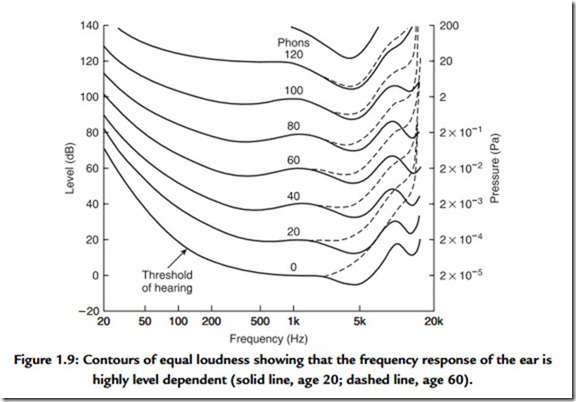Level and Loudness
At its best, the ear can detect a sound pressure variation of only 2 X 10-5 Pascals root mean square (rms) and so this figure is used as the reference against which the sound pressure level (SPL) is measured. The sensation of loudness is a logarithmic function of SPL; consequently, a logarithmic unit, the decibel, was adopted for audio measurement. The decibel is explained in detail in Section 1.12.
The dynamic range of the ear exceeds 130 dB, but at the extremes of this range, the ear either is straining to hear or is in pain. The frequency response of the ear is not at all uniform and it also changes with SPL. The subjective response to level is called loudness and is measured in phons. The phon scale is defined to coincide with the SPL scale at
1 kHz, but at other frequencies the phon scale deviates because it displays the actual SPLs judged by a human subject to be equally loud as a given level at 1 kHz. Figure 1.9 shows the so-called equal loudness contours, which were originally measured by Fletcher and Munson and subsequently by Robinson and Dadson. Note the irregularities caused by resonances in the meatus at about 4 and 13 kHz.
Usually, people’s ears are at their most sensitive between about 2 and 5 kHz; although some people can detect 20 kHz at high level, there is much evidence to suggest that most listeners cannot tell if the upper frequency limit of sound is 20 or 16 kHz.2,3 For a long time it was thought that frequencies below about 40 Hz were unimportant, but it is now clear that the reproduction of frequencies down to 20 Hz improves reality and ambience.4
The generally accepted frequency range for high-quality audio is 20 to 20,000 Hz, although an upper limit of 15,000 Hz is often applied for broadcasting.
The most dramatic effect of the curves of Figure 1.9 is that the bass content of reproduced sound is reduced disproportionately as the level is turned down. This would suggest that if a sufficiently powerful yet high-quality reproduction system is available, the correct tonal balance when playing a good recording can be obtained simply by setting the volume control to the correct level. This is indeed the case. A further consideration is that many musical instruments, as well as the human voice, change timbre with the level and there is only one level that sounds correct for the timbre.
Audio systems with a more modest specification would have to resort to the use of tone controls to achieve a better tonal balance at lower SPL. A loudness control is one where the tone controls are automatically invoked as the volume is reduced. Although well meant, loudness controls seldom compensate accurately because they must know the original level at which the material was meant to be reproduced as well as the actual level in use.
A further consequence of level-dependent hearing response is that recordings that are mixed at an excessively high level will appear bass light when played back at a normal level. Such recordings are more a product of self-indulgence than professionalism.
Loudness is a subjective reaction and is almost impossible to measure. In addition to the level-dependent frequency response problem, the listener uses the sound not for its own sake but to draw some conclusion about the source. For example, most people hearing a distant motorcycle will describe it as being loud. Clearly, at the source, it is loud, but the listener has compensated for the distance.
The best that can be done is to make some compensation for the level-dependent response using weighting curves. Ideally, there should be many, but in practice the A, B, and
C weightings were chosen where the A curve is based on the 40-phon response. The measured level after such a filter is in units of dBA. The A curve is almost always used because it most nearly relates to the annoyance factor of distant noise sources.
